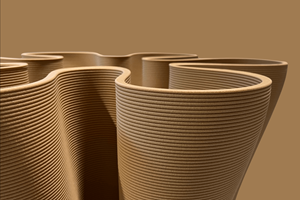REFRESH wind blade recycling data shows promising environmental benefits
Initial LCA processing carbon and glass fibers evaluates mechanical and thermal recycling methods, finds environmental reduction impact surpasses the impact associated with the recycling processes themselves.
Share
Source | Jason Bickley
In an update on the EU-funded project launched in 2023, its consortium has published promising results from the initial life cycle assessment (LCA) of the project’s processes for recycling glass and carbon fiber-reinforced composites from end-of-life (EOL) wind turbine blades. The analysis highlights significant environmental benefits for the REFRESH mechanical recycling and thermal recycling processes compared to traditional disposal methods, including a reduction in climate change impacts of >70% for the thermal processes compared to incineration.
The evaluation of advanced recycling techniques, including microwave- assisted pyrolysis, remain under-explored in existing environmental assessments. This study, based on high-quality primary and experimental data sourced from the project’s partners, provides a comprehensive and data-driven assessment of innovative recycling processes for composites derived from EOL blades, a topic of increasing importance in the transition to a circular economy. The study included a detailed hotspot analysis, providing actionable insights for reducing environmental impacts across different process phases.
Conducted by the project’s coordinator Rina Consulting (Genova, Italy) in the initial phase of the project, the analysis followed ISO 14040 and 14044 standards. The functional unit for the analysis was defined as the recycling of 1 ton of EOL wind turbine blades, and covered REFRESH’s three main recycling processes: mechanical recycling and two thermal processes, pyrolysis and microwave-assisted pyrolysis (MW-pyrolysis).
Calculations were performed using the GaBi LCA for Expert software. The study focused on three main impact categories: climate change, resource use (fossils) and resource use (minerals and metals). The characterization method used was the Environmental Footprint (EF) 3.1 method, which is aligned with the latest standards and EU recommendations.
Overall, the comprehensive LCA provided a thorough evaluation of the environmental impacts across the entire lifespan of the recycling processes.
Mechanical recycling demonstrated a 2% reduction in environmental impact compared to landfilling. Despite the relatively low percentage reduction, it is important to highlight the generation of secondary raw materials through the recycling process.
The thermal recycling processes, pyrolysis and microwave-assisted pyrolysis, demonstrated a 71% and 72% reduction in climate change impact, respectively, compared to incineration. This highlights the potential of these processes for significantly reducing greenhouse gas emissions.
The study also revealed that the environmental benefits of using recycled fibers in relevant industries (for example, lightweight structures and textiles) as secondary raw materials, were significantly greater than the impacts associated with the recycling processes themselves. This means that although recycling involves energy consumption and emissions, avoiding the impacts associated with production of virgin fibers (which is typically energy-intensive and resource-demanding) results in a net environmental gain. Therefore, substituting virgin materials with recycled fibers represents a significantly more sustainable option.
All three recycling processes demonstrate significant environmental benefits compared to the impact of the recycling process itself. Figures 1, 2 and 3 show the global warming potential (GWP) benefits offered by the mechanical recycling and thermal recycling processes.
This initial LCA analysis indicates that the REFRESH recycling processes have the potential to significantly reduce environmental impacts compared to traditional disposal methods. The environmental benefits of using recycled materials further support the project’s goals of promoting circular economy practices and reducing reliance on virgin materials. Next steps involve optimizing these processes, assessing the final use of the recycled materials and conducting an economic and social assessment to maximize REFRESH’s sustainability potential.
Related Content
Sulapac introduces Sulapac Flow 1.7 to replace PLA, ABS and PP in FDM, FGF
Available as filament and granules for extrusion, new wood composite matches properties yet is compostable, eliminates microplastics and reduces carbon footprint.
Read MoreCo-molding SMC with braided glass fiber demonstrates truck bed potential
Prepreg co-molding compound by IDI Composites International and A&P Technology enables new geometries and levels of strength and resiliency for automotive, mobility.
Read MoreOtto Aviation launches Phantom 3500 business jet with all-composite airframe from Leonardo
Promising 60% less fuel burn and 90% less emissions using SAF, the super-laminar flow design with windowless fuselage will be built using RTM in Florida facility with certification slated for 2030.
Read MoreRevisiting the OceanGate Titan disaster
A year has passed since the tragic loss of the Titan submersible that claimed the lives of five people. What lessons have been learned from the disaster?
Read MoreRead Next
Tech-Fab Europe publishes LCA study on glass fiber fabrics
The association’s study reveals the benefits of strengthening European supply chain for glass fiber fabrics to help decarbonize in line with EU net-zero targets.
Read MoreWind blade recycling project presents objectives, progress
JEC World 2025: Six of the REFRESH project’s 11 partners are highlighting their efforts to build a circular and sustainable value chain for decommissioned GFRP wind blades.
Read MoreUltrasonic welding for in-space manufacturing of CFRTP
Agile Ultrasonics and NASA trial robotic-compatible carbon fiber-reinforced thermoplastic ultrasonic welding technology for space structures.
Read More









